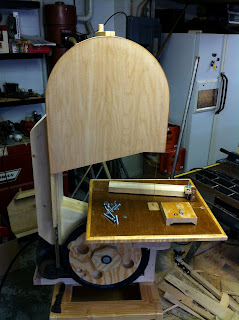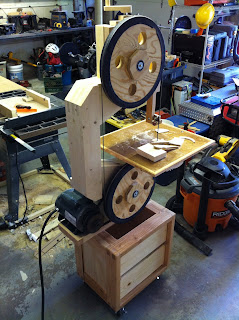The upper blade guide beam needs a place to travel against the upper enclosure. The plans call for the entire section of enclosure to be cut out, but I chose otherwise. I set up two fences with a flush straight bit on the router to cut a 'dado' for the beam. This only took a few minutes.
The top enclosure can now sit flush against the frame, while allowing the blade guide to move. I'll later need to work out how to mount the blade guide cover to the beam and allow it to move all the way up. I have a few ideas which should work.
Underneath.
The lower enclosure will hinge like the top, and this is the left side bottom. This piece of wood has cutouts for the motor pulley and belt. Sorry for not showing the bigger picture.
The lower back enclosure is angled to direct dust. It is screwed in place to the frame.
The top of the bottom wheel is covered with this angled piece. Two screws mount it to the frame.
The lower enclosure cutout shown earlier will have a hinge installed. The location down the center will intersect with the cutouts for the motor pulley, so the hinge will be split. I've already done this, but forgot to include a picture.
The lower enclosure door gets joined from two scrap pieces of 1/4" plywood. This was repeated for the maple veneer.
4 strips of poplar provide support for the door. The poplar, plywood, and veneer were pressed in the vacuum press. I left it pressed for >24 hours in hopes warping would be minimized. So far, it has worked.
The section of upper enclosure needed extra rigidity from where the blade guide channel was routed. A bit of maple veneer essentially doubled the thickness behind that channel. At the top of the picture you can see the front of the upper enclosure. Pittsburgh has cycled through a mid/high 80's week followed by storms and a weekend of mid 50's. The change in humidity and temp warped the front enclosure so much, a straightedge against the front showed a 1/4" inward bow. This is unacceptable. I chiseled off the wimpy pine supports and replaced them with ~1/2" oak. After clamping them to the enclosure for >24 hours, the frame is nice and flat. Much better.
Progress is incredibly slow. I'm way off from the plans, so most of the enclosure is being built as I go along. This involves staring at the saw for 2 hours, holding a piece of pine against it for 2 minutes, then back to staring. Eventually some actual cutting and gluing fits in there.



































































